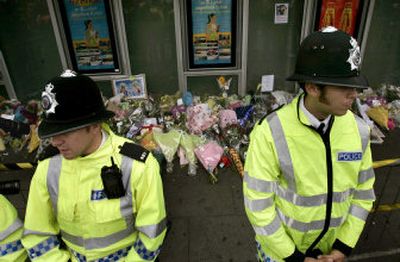Police believe terrorists used synchronized timing devices

LONDON – The bombs that ripped through three London subway trains during Thursday’s morning rush hour were high explosives triggered almost simultaneously, most likely by synchronized timing devices rather than by suicide bombers, according to a revised account released on Saturday by police.
After examining computer data, electrical equipment and eyewitness statements, investigators have concluded the three bombs were set off within 50 seconds of one another, officials told a news conference. “It was bang, bang, bang – very close together,” said Tim O’Toole, managing director of the London Underground.
The disclosure came on a tense day as officials closed off parts of central Birmingham, Britain’s second largest city, due to an unspecified security threat, and authorities warned that the bombers may still be at large. About 20,000 people were evacuated, and police carried out four controlled explosions of suspicious items, but officials later said they believed the alert was not connected to the London bomb attacks.
Officials had originally reported a 26-minute gap between the first and third bombs. They attributed the discrepancy to the fact that no one phoned in the explosion at the Edgware Road station as a bomb until 9:17 a.m. – some 25 minutes after it actually occurred.
The three blasts, and a fourth explosion that tore through a double-decker bus nearly an hour later, killed at least 49 people and injured 700. Another 25 people are missing and feared dead, most of them entombed in the wreckage of a Piccadilly Line train in a narrow tunnel some 70 feet below ground.
The new details match the leading theory that is emerging among investigators, analysts said: that the bombings were a technically competent and well-coordinated attack planned and overseen by at least one experienced and well-trained operative using commercially manufactured explosives, and carried out by local people.
Such a pattern would fit previous bomb attacks in Casablanca in May 2003 and Madrid in March 2004. In each case, an operative from outside the country trained in Islamic extremist camps in Afghanistan or Pakistan used local people with no known links to terrorism to carry bombs to their targets. Irish Republican Army guerrillas used similar local helpers – known here as “lily whites” because they had no police record – in their decades-long bombing campaign against British rule in Northern Ireland.
“Their major hypothesis is that this is basically a homegrown group with external help or inspiration,” said Michael Clarke, director of the International Policy Institute at King’s College London, who has close ties to security officials. “A plausible pattern is that professionals from abroad come in and set the thing up and the lily whites go and do it.”
Prime Minister Tony Blair defended the security services from allegations that they had been caught by surprise by Thursday’s attacks. The government was doing everything it could to protect the country, he told the BBC, but “if people are actually prepared to go onto a tube or a bus and blow up wholly innocent people, people just at random, to do the maximum death and destruction without any thought for their human rights or human life, you can have all the surveillance in the world and you couldn’t stop that happening.”
Two Islamic extremist groups have asserted responsibility for the attacks, which brought central London to a standstill.
Meanwhile, rescue workers and forensic experts continued their painstaking effort to extricate the dead and gather evidence from the Piccadilly train, located between the King’s Cross and Russell Square stations, scene of Thursday’s largest death toll.
Contrary to earlier reports, officials said the tunnel was undamaged. But they said heat, lack of ventilation, tight space, vermin and the trauma of working among mangled bodies made the task slow and horrific.
“It is extremely hot, very dusty and quite dangerous down there and it is a great challenge for them to continue their work to recover the remaining bodies,” said Andy Trotter, deputy chief constable of the British Transport Police. “It will be some time before this job is completed.”
Officials refused to say how many bodies had been found or how many more might be enclosed in the rubble. They said none of the victims had been officially identified.
“This was a high explosive detonated in a very confined space,” said Brian Paddick, a senior constable in Scotland Yard, headquarters of London’s police force. “You can quite clearly understand why it is not absolutely clear how many people may be in that carriage.”